|
-
01-05-2018, 07:06 AM
#101
Super Member

Re: Rotary VS Dual Action for Compounding
 Originally Posted by jslym777

Achieving results in less time - Assuming you know how to use both machines professionally and assuming you can use any pad/compound option, it seems as though using a rotary for compounding is still the most efficient way to go. (I am talking about compounding, not finishing.)
For full finish correction then, using a rotary, followed up with a DA for finishing - you yield best results using the least amount of time.
- Please chime in on your thoughts
Chiming in late. Rotary user here but one that hasn't picked his up for quite a while. The last time I did was on a really, really bad vehicle that had some serious defects.
Overall the main reason I don't use one much is that a purple wool pad on my Flex 3401 with Meg's 101 will cut through just about anything with ease and it leaves the paint in such great shape that all that's required is a light polish with a light polishing pad.
The benefits outwiegh the time savings:
Far Safer. I know how to use a rotary and have for many years. That said, accidents do happen, paints are not all the same and honestly, it will remove more clear/finish regardless of how careful you are. That's a byproduct of the time savings.
Better / Easier Finish. Purple wool with the right compound leaves the compounding phase with so little haze that a light polish is all that's left.
I still keep my rotary handy and will break it out now and then but haven't missed it much on the vehicles I've been working on. I use it selectively when and where needed.
2019 Pearl White Accord 2.0T Touring (mine)
2023 Snowflake Pearl White CX-30 Turbo Premium Plus(wife)
2010 Urban Platinum Metallic CRV EX-L & 2014 Mica Black Metallic Toyota Corolla S (kids)
-
Post Thanks / Like - 0 Thanks, 1 Likes, 0 Dislikes
-
01-05-2018, 07:49 AM
#102
Re: Rotary VS Dual Action for Compounding
 Originally Posted by jslym777

My troubles and questions stem from the marketing aspects of the new DAs.
Probably no fix for this as you can't change how all the companies in the word operate. Your questions are good but still, you can't change the historical way 99.95 of all companies market their products.
Everyone says their stuff is the best. That's normal. Who would put out a product onto the market and advertise it's not very good?
 Originally Posted by jslym777

The claims they make that you can get perfection, don't need skilled detailers anymore and can do perfect paint correction in shorter times with no risk.
My guess is that's a way of reaching out to new people that may have fears about machine polishing.
Point of fact - I reach out to new people every day and let them know that even though they are BRAND NEW to machine polishing, they can get professional results their very first time. Been saying this for years now.
Why?
Mostly due to three things,
1: Abrasive technology - It's so good you don't have to be good to get good results.
2: Tools - Used to be all we had was the rotary buffer and IN THAT TIME PERIOD all we had was crappy abrasive technology and wool pads - so "yes" you actually had to have some skill and experience to get good results. Great results did not come along until the foam pad was invented in 1965 by Walter Cotton.
3: Pad technology - Again... used to be just one pad option. Then later all that was available was HUGE diameter pads and THICK pads. That's all changed now. Who would have though 50, 40, 30, 20 and even 10 years ago we would have 1" pads?
This is why I always type/say I'm a perpetual student. There's NO WAY anyone can be an expert. There's simply too much new technology being introduced at break-neck speed that the only way one can hope and try, (that's two things), to stay caught up is to hang out on a forum like this.
Last year I wrote approximately 109 new articles. Here's a screenshot of the forum groups that show this...

Out of the 109 articles, the two I shared the most were these two,
Here's what you need to get into machine polishing - Recommendations for a beginner by Mike Phillips
How, why & when to inspect your microfiber towels when detailing cars
The first article was written specifically to reach out to NEW PEOPLE that want to make the leap from working by hand to working by machine. Taking normal things like fear and apprehensiveness into consideration plus a person's willingness to break open the bank to get started, I recommended the Griot's Garage 6" Random Orbital Polisher. The BIG PICTURE is that with this tool and MODERN abrasive technology and quality pads anyone that can focus their brand and has enough muscle to grip the tool and guide it in an overlapping crosshatch patter can get professional result their very first time.
And the Lord knows myself and many others have posted horror stories over and over again on this forum sharing where a car was destroyed by a hack detailer (supposed to be "Pro"), or by taking their car to a dealership and having the dealership's staff wash or detail their car, (supposed to be pros), and if that is the criteria then I'd put my money on any newbie, buying the Griot's 6" ROP and then coming here to get start-up guidance any day of the week.
If fact, back in 2012, 6 years ago I wrote this article and it's the PICTURES that tell the story...
Machine polishing paint - It's not that hard and with modern dual action polishers it's real safe!
 Originally Posted by jslym777

I just don't agree with all of that and to me sounds gimmicky,
I think there's a valid point that can and is being made that "yes" a brand new person using quality tools, abrasive technology and pads can in fact get professional result their very first time and without using a rotary buffer in most cases.
I'll go on record as saying the below and note that as a veteran of the NXT vs Zaino Wax Wars I am very good at picking and choosing each and every single word I use on this forum and in the sentence below.
"The use of the rotary buffer is the fastest way to remove defects, (remove paint) no matter what the shape of the panel and from paint that is close to edges and or objects"
And the reason I included the last portion in that sentence about buffing near objects is because with any free spinning orbital and to a lesser degree with gear driven orbital polishers, it's more difficult to apply cutting ability to the outer edge of the pad because when the pad is oscillating only a portion of the pad is in contact with the paint near the object AND when the spinning pad comes into contact with the edge of the object the friction between the pad and the object will slow or stall pad rotation for free spinning tools. I think the 5mm gear driven orbitals like the Makita PO500C and the RUPES Mille are able to do correction work to the paint next to an object and an edge or raised body line (and for sure curved panels), but overall the rotary buffer still trumps all other tool options simply due to the single direction rotating action and the ability to buff right up to the surface of a protruding object (affixed to a body panel), without pad stall. Plus there are small pad options for rotary drive tools that also make the rotary tool action more effective.
The may be a lot to digest if you have not used most or all of the tools on the market of which I think it's safe to say I have, at least out of U.S. based options.
These pictures and the description from post #28 of my review here kind of show what I mean...
Review: RUPES BIGFOOT MILLE LK 900E by Mike Phillips
 Originally Posted by RSW

BTW, Mike.
Did you notice that because the Mille is more effective out on the edge you got a better result in tight places and didn't have to reach for a different machine on posts etc.?
RSW
 Originally Posted by Mike Phillips
Yes and I believe that is for two reasons working together.
it's the shorter stroke or orbit stroke length plus the gear-driven aspect that makes it easier to do correction near edges.
With a long stroke free spinning tool, as the outer edge of a pad hits anything it tends to cause the pad to stall out.
In my RUPES how-to book
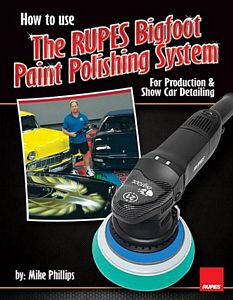
On page 55, I created a term called,
The Ghosting footprint and the actual footprint
Here's page 54 and 55

Down just to the right of my thumb is this section...
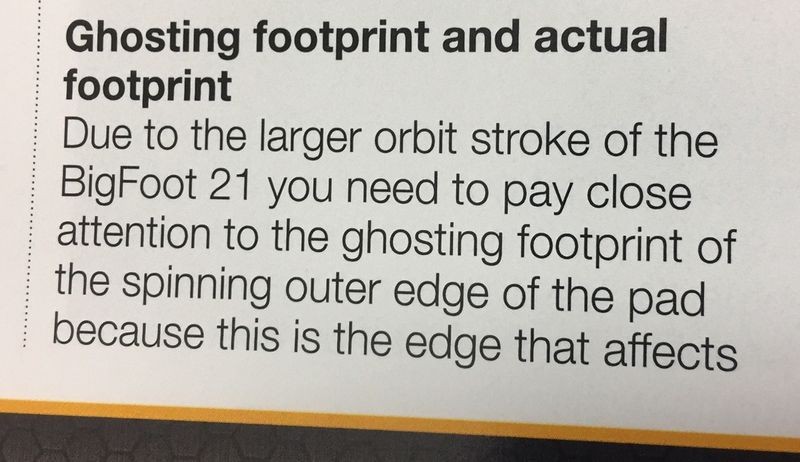
When you look down at a 21mm, 15mm or 12mm long stroke orbital polisher - if you look carefully you'll see two perimeters... the outer perimeter is the ghosting footprint as there is not 100% pad contact 100% of the time. The inner perimeter is the actual footprint and there is 100% of pad contact 100% of the time.
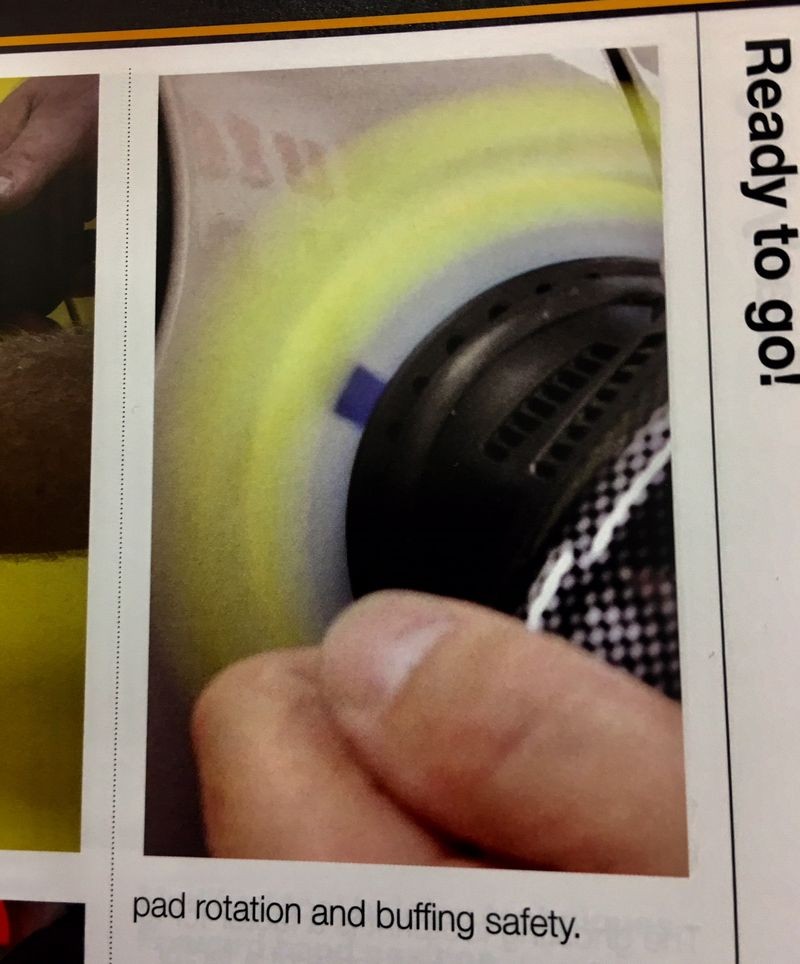
I'm not very good in PS so here's the best I could do using the images already in the book.
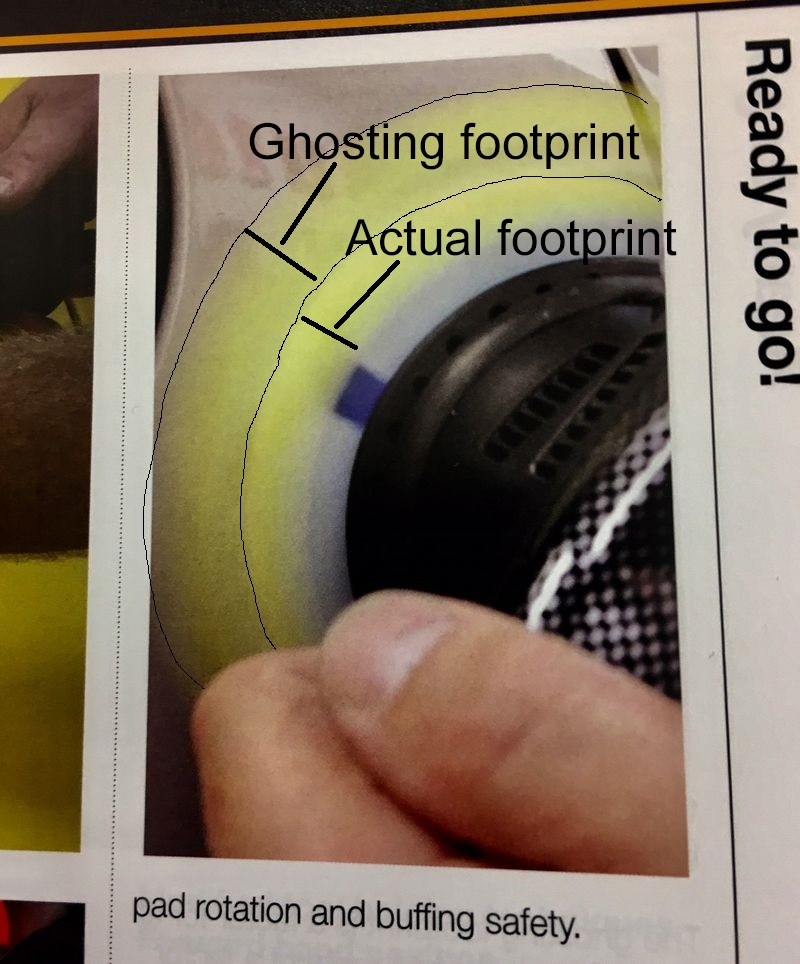
(It's powerful to know how to work with pictures, write and then remember where all this stuff is at  ) )
 Originally Posted by jslym777

lowers the perceived standard of a professional and lowers the prices detailers can charge for paint correction.
Hack work lowers the standard for quality for our industry as well as the image and perception of our industry.
Getting a high or fair price for you work comes down to,
A: Your own skill, ability and experience
B: Educating your customer and differentiating yourself from the hacks that work for subpar prices in our industry.
I teach both of the above in all my 3-day classes here at Autogeek.

-
Post Thanks / Like - 0 Thanks, 1 Likes, 0 Dislikes
-
01-05-2018, 08:26 AM
#103
Super Member

Re: Rotary VS Dual Action for Compounding
 Originally Posted by Mike Phillips

And the reason I included the last portion in that sentence about buffing near objects is because with any free spinning orbital and to a lesser degree with gear driven orbital polishers, it's more difficult to apply cutting ability to the outer edge of the pad because when the pad is oscillating only a portion of the pad is in contact with the paint near the object AND when the spinning pad comes into contact with the edge of the object the friction between the pad and the object will slow or stall pad rotation for free spinning tools.
This is very true. I suffer greatly with this problem whenever I polish the surrounding areas near my fabric top. Just a few days ago I was testing out the new Blackfire polish and sure enough it happened.. I got too close to the edge with the 21mm polisher and made a nice white mark on the fabric.
I hate when it happens because I know I wonít get around to cleaning it for a while.. Reason for that is I want to polish and seal the paint, and once itís polished I donít want to aggressively clean the fabric right next to it. Itís mostly in my head and I should just clean it, but Iím stubborn. Lol.
I canít ever get any tape to stick to the fabric so my only option is to be careful and hope I donít bump into it. Slim chance when using a 21mm polisher.
-
01-05-2018, 08:37 AM
#104
Re: Rotary VS Dual Action for Compounding
-
Post Thanks / Like - 1 Thanks, 0 Likes, 0 Dislikes
-
01-05-2018, 08:58 AM
#105
Re: Rotary VS Dual Action for Compounding
That paint is stunning. Fantastic tip with the taping. Thank you
-
01-05-2018, 09:01 AM
#106
Super Member

Rotary VS Dual Action for Compounding
 Originally Posted by Mike Phillips

It's a tick difficult if you're treated it with a protectant.
There is a trick though, whether the top is treated or not, and that's to use tension as your friend. I have pictures showing this and I show it in all my 3-day classes.
All you need to do is use something next to the top like the window glass as an "anchor point". Then run the tape along the bottom edge and all the way around to the other side and again, anchor it to something NOT fabric.
Look at the below picture closely, (I can actually find the original full size and crop out the portion to show it better),
See where the tape is attached to the glass?
That's my anchor point.

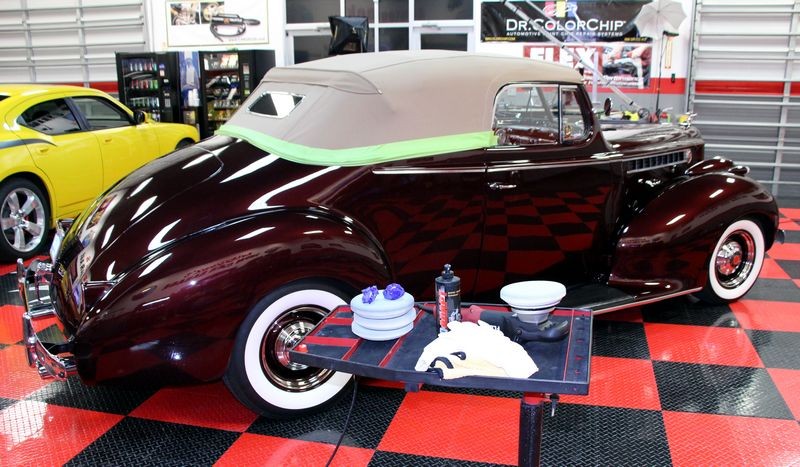

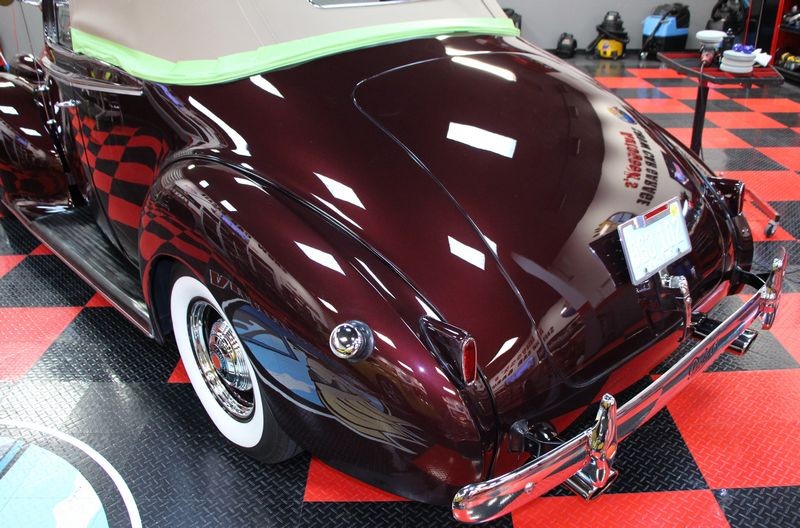
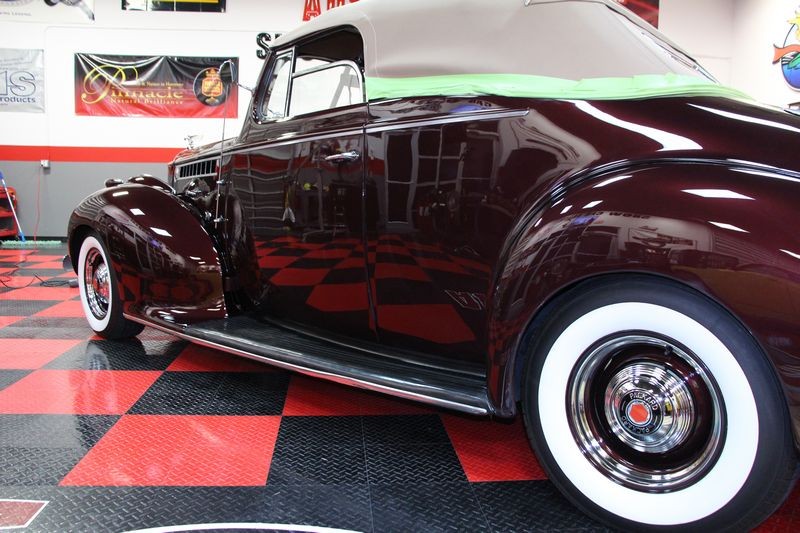
The above is from this car I detailed a few years ago -happy to say the owner has done a great job of maintaining the finish.
3D HD Adapt and Poxy Review - 1940 Studebaker Streetrod detailed by Mike Phillips
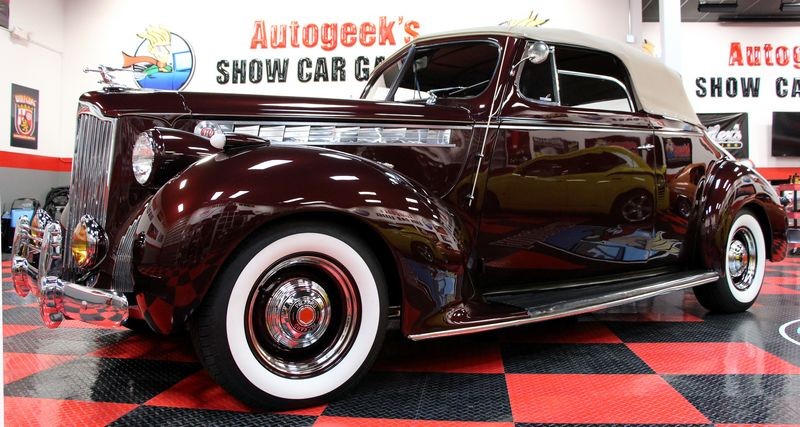

Totally spot on [and perfectly done too. Wow that looks nice] 
I know it can be done if it had to... But you know how we can sometimes be with our own vehicles, especially if theyíre daily drivers that are far from perfect. I tend to be alot more forgiving on my own car than I would ever be with someone elseís car thatís in my hands. 
Youíre absolutely right, tension, and focus on perfection. [and plenty of tape] Iíve definitely thought about it.
-
01-05-2018, 09:07 AM
#107
Re: Rotary VS Dual Action for Compounding
I use a rotary for small pad use cutting close to objects like you are talking about more often than I use the rotary for compounding the entire car. Compounding sucks and to me a rotary is the smoothest method on all panel types. Once you get your arm/hand positions and grip down it is not that scary. No need to go above 1200 RPM high speeds are not necessary. I work in the 800-1000 range when working on panels. I also think that the paint looks cleaner when the cutting step was via rotary.
-
Post Thanks / Like - 0 Thanks, 2 Likes, 0 Dislikes
-
01-05-2018, 11:19 AM
#108
Super Member

Re: Rotary VS Dual Action for Compounding
 Originally Posted by dlc95

You need to be more specific as to what kind of d/a, and to how It's set up.
You talking random orbital (what orbit stroke?) or forced? You talking microfiber / wool pads and heavy cut compound? New, modern compounds, or old technology.
Give specifics.
It comes off like you already know your answer and are looking for a fight.
I agree, every time someone suggests a strong combo DA you ask why that combo isnt as dangerous as a rotary. Not sure where that came from. Im confused
"Dirt likes detergent so much better than the surface that it's attached to, it'll leave that surface to go hang out with the soap"... aim4squirrels
-
01-05-2018, 01:14 PM
#109
Super Member

Re: Rotary VS Dual Action for Compounding
 Originally Posted by jslym777

Heat used to be more of an issue as compounds had shorter working times, rotaries were used at higher speeds, and people were relearning how to use rotaries on newer paints. Just as DAs have come a long way, so have rotaries. I don't have the mindset that you should only do detailing one way. My troubles and questions stem from the marketing aspects of the new DAs. The claims they make that you can get perfection, don't need skilled detailers anymore and can do perfect paint correction in shorter times with no risk. I just don't agree with all of that and to me sounds gimmicky, lowers the perceived standard of a professional and lowers the prices detailers can charge for paint correction.
I have to wholeheartedly agree with your perspective on the marketing, and the myth that putting a rotary buffer to paint will immediately remove all the paint from the surface. It's fostered an unnecessary fear of this tool. For an enthusiast, or even a weekend warrior, relying soley on orbital polishers - that tool will probably suit that person just fine.
However, many crossing over into the professional realm seem to be ignoring the rotary. In the professional realm, this could be a hinderance. I've been called to assist in production environments, where part of their process includes cutting with a rotary. That was/is the shop owner's process. To be frank, I made a lot of money helping this guy out - because I could operate the rotary, and perform HIS system.
Now, this same guy is the one who let me try his Rupes MK2, that was set up for high performance cutting, and in MY hands cut faster than the rotary, but I was not comfortable with it. Yvan LaCroix also reported that the 21mm tool he uses, with the wool pad he uses also cut faster- but his preference in that application is the rotary...
But yeah, some of the marketing techniques can get bothersome.
-
Post Thanks / Like - 0 Thanks, 1 Likes, 0 Dislikes
-
01-05-2018, 05:08 PM
#110
Super Member

Re: Rotary VS Dual Action for Compounding
 Originally Posted by dlc95

I have to wholeheartedly agree with your perspective on the marketing, and the myth that putting a rotary buffer to paint will immediately remove all the paint from the surface. It's fostered an unnecessary fear of this tool. For an enthusiast, or even a weekend warrior, relying soley on orbital polishers - that tool will probably suit that person just fine.
However, many crossing over into the professional realm seem to be ignoring the rotary. In the professional realm, this could be a hinderance. I've been called to assist in production environments, where part of their process includes cutting with a rotary. That was/is the shop owner's process. To be frank, I made a lot of money helping this guy out - because I could operate the rotary, and perform HIS system.
Now, this same guy is the one who let me try his Rupes MK2, that was set up for high performance cutting, and in MY hands cut faster than the rotary, but I was not comfortable with it. Yvan LaCroix also reported that the 21mm tool he uses, with the wool pad he uses also cut faster- but his preference in that application is the rotary...
But yeah, some of the marketing techniques can get bothersome.
What a fantastic post
-
Post Thanks / Like - 1 Thanks, 1 Likes, 0 Dislikes
 dlc95
dlc95 thanked for this post
Similar Threads
-
By asap2stacks in forum Auto Detailing Tools and Accessories
Replies: 7
Last Post: 07-25-2017, 05:06 PM
-
By dhsv2 in forum Auto Detailing 101
Replies: 0
Last Post: 09-02-2014, 11:01 PM
-
By sabresfan in forum Rotary Buffers
Replies: 14
Last Post: 09-07-2012, 01:31 PM
-
By surajprasade in forum Ask your detailing questions!
Replies: 11
Last Post: 12-05-2011, 02:45 AM
-
By AndrewBall in forum Ask your detailing questions!
Replies: 25
Last Post: 09-22-2010, 09:27 AM
 Members who have read this thread: 0
Members who have read this thread: 0
There are no members to list at the moment.
 Posting Permissions
Posting Permissions
- You may not post new threads
- You may not post replies
- You may not post attachments
- You may not edit your posts
-
Forum Rules
|
| S |
M |
T |
W |
T |
F |
S |
| 31 |
1
|
2
|
3
|
4
|
5
|
6
|
|
7
|
8
|
9
|
10
|
11
|
12
|
13
|
|
14
|
15
|
16
|
17
|
18
|
19
|
20
|
|
21
|
22
|
23
|
24
|
25
|
26
|
27
|
|
28
|
29
|
30
| 1 | 2 | 3 | 4 |
|












 Thanks:
Thanks:  Likes:
Likes:  Dislikes:
Dislikes: 


 Reply With Quote
Reply With Quote





 )
)


Bookmarks